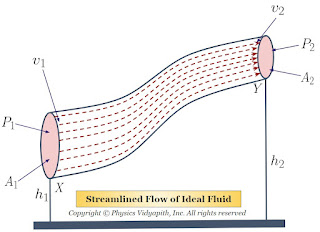Maxwell's Equations:
Maxwell's equation of the electromagnetic wave is a collection of four equations i.e. Gauss's law of electrostatic, Gauss's law of magnetism, Faraday's law of electromotive force, and Ampere's Circuital law. Maxwell converted the integral form of these equations into the differential form of the equations. The differential form of these equations is known as Maxwell's equations.
- $\overrightarrow{\nabla}. \overrightarrow{E}= \frac{\rho}{\epsilon_{0}}$
- $\overrightarrow{\nabla}. \overrightarrow{B}=0$
- $\overrightarrow{\nabla} \times \overrightarrow{E}=-\frac{\partial \overrightarrow{B}}{\partial t}$
- $\overrightarrow{\nabla} \times \overrightarrow{H}= \overrightarrow{J}$
Modified form:
$\overrightarrow{\nabla} \times \overrightarrow{H}= \overrightarrow{J}+ \frac{\partial \overrightarrow{D}}{\partial t}$
For Conducting Media:
Current density $(\overrightarrow{J}) = \sigma \overrightarrow{E} $
Volume charge distribution $(\rho)=0$
Permittivity of Conducting Media= $\epsilon$
Permeability of Conducting Media=$\mu$
Now, Maxwell's equation for Conducting Media:
$\overrightarrow{\nabla}. \overrightarrow{E}=0 \qquad(1)$
$\overrightarrow{\nabla}. \overrightarrow{B}=0 \qquad(2)$
$\overrightarrow{\nabla} \times \overrightarrow{E}=-\frac{\partial \overrightarrow{B}}{\partial t} \qquad(3)$
$\overrightarrow{\nabla} \times \overrightarrow{H}= \overrightarrow{J}$
Modified form for Conducting Media:
$\overrightarrow{\nabla} \times \overrightarrow{H}= \overrightarrow{J}+ \frac{\partial \overrightarrow{D}}{\partial t} $
$\overrightarrow{\nabla} \times \overrightarrow{H}= \sigma \overrightarrow{E}+ \epsilon \frac{\partial \overrightarrow{E}}{\partial t} \qquad(4)$
Now, On solving Maxwell's equation for conducting media i.e perfect dielectric and lossless media, gives the electromagnetic wave equation for conducting media. The electromagnetic wave equation has both an electric field vector and a magnetic field vector. So Maxwell's equation for conducting medium gives two equations for electromagnetic waves i.e. one is for electric field vector($\overrightarrow{E}$) and the second is for magnetic field vector ($\overrightarrow{H}$).
Electromagnetic wave equation for conducting media in terms of $\overrightarrow{E}$:
Now from equation $(3)$
$\overrightarrow{\nabla} \times \overrightarrow{E}=-\frac{\partial \overrightarrow{B}}{\partial t} $
Now take the curl on both sides of the above equation$
$\overrightarrow{\nabla} \times (\overrightarrow{\nabla} \times \overrightarrow{E})=-\overrightarrow{\nabla} \times \frac{\partial \overrightarrow{B}}{\partial t} $
$(\overrightarrow{\nabla}. \overrightarrow{E}).\overrightarrow{\nabla} - (\overrightarrow{\nabla}. \overrightarrow{\nabla}).\overrightarrow{E}=-\frac{\partial}{\partial t} (\overrightarrow{\nabla} \times \overrightarrow{B}) \qquad(5)$
But for conducting medium:
$\overrightarrow{\nabla}. \overrightarrow{E}=0 \qquad \left( From \: equation (1) \right)$
$\overrightarrow{\nabla}.\overrightarrow{\nabla}=\nabla^{2}$
$\overrightarrow{\nabla} \times \overrightarrow{B}=\sigma \mu \overrightarrow{E} + \mu \epsilon \frac{\partial \overrightarrow{E}}{\partial t} \qquad \left( From \: equation (4) \right)$
Now substitute these values in equation $(5)$. So
$ -\nabla^{2}.\overrightarrow{E}=-\frac{\partial}{\partial t} \left(\sigma \mu \overrightarrow{E} + \mu \epsilon \frac{\partial \overrightarrow{E}}{\partial t} \right)$
$ -\nabla^{2}.\overrightarrow{E}=-\mu \frac{\partial}{\partial t} \left(\sigma \overrightarrow{E} + \epsilon \frac{\partial \overrightarrow{E}}{\partial t} \right)$
$ \nabla^{2}.\overrightarrow{E}=\mu \epsilon \frac{\partial^{2} \overrightarrow{E}}{\partial t^{2}} + \sigma \mu \frac{\partial \overrightarrow{E}}{\partial t} $
$ \nabla^{2}.\overrightarrow{E}-\mu \epsilon \frac{\partial^{2} \overrightarrow{E}}{\partial t^{2}} - \sigma \mu \frac{\partial \overrightarrow{E}}{\partial t}=0 $
The value of $\frac{1}{\sqrt{\mu \epsilon}}= v$. Where $v$ is the speed of the electromagnetic wave in the conducting medium. So the above equation is often written as
$ \nabla^{2}.\overrightarrow{E}-\frac{1}{v^{2}}\frac{\partial^{2} \overrightarrow{E}}{\partial t^{2}} - \sigma \mu \frac{\partial \overrightarrow{E}}{\partial t}=0 $
This is an electromagnetic wave equation for conducting media in terms of electric field vector ($\overrightarrow{E}$).
Electromagnetic wave equation for conducting media in terms of $\overrightarrow{H}$:
Now from equation $(4)$
$\overrightarrow{\nabla} \times \overrightarrow{H}= \sigma \overrightarrow{E}+ \epsilon \frac{\partial \overrightarrow{E}}{\partial t}$
Now take the curl on both sides of the above equation
$\overrightarrow{\nabla} \times (\overrightarrow{\nabla} \times \overrightarrow{H})=\overrightarrow{\nabla} \times \left( \sigma \overrightarrow{E}+ \epsilon \frac{\partial \overrightarrow{E}}{\partial t} \right) $
$(\overrightarrow{\nabla}. \overrightarrow{H}).\overrightarrow{\nabla} - (\overrightarrow{\nabla}. \overrightarrow{\nabla}).\overrightarrow{H}=\overrightarrow{\nabla} \times \sigma \overrightarrow{E}+ \epsilon \left( \overrightarrow{\nabla} \times \frac{\partial \overrightarrow{E}}{\partial t} \right)$
$(\overrightarrow{\nabla}. \overrightarrow{H}).\overrightarrow{\nabla} - (\overrightarrow{\nabla}. \overrightarrow{\nabla}).\overrightarrow{H}=\sigma \left( \overrightarrow{\nabla} \times \overrightarrow{E} \right)+ \epsilon \frac{\partial }{\partial t}\left( \overrightarrow{\nabla} \times \overrightarrow{E} \right) \qquad(6)$
But for conducting media:
$\overrightarrow{\nabla}. \overrightarrow{H}=0 \qquad \left( from \: equation (2) \right)$
$\overrightarrow{\nabla}.\overrightarrow{\nabla}=\nabla^{2}$
$\overrightarrow{\nabla} \times \overrightarrow{E}= -\frac{\partial \overrightarrow{B}}{\partial t} \qquad \left( from \: equation (3) \right)$
Now substitute these values in equation $(6)$. So
$-\nabla^{2}.\overrightarrow{H}=- \sigma \frac{\partial \overrightarrow{B}}{\partial t} - \epsilon \frac{\partial^{2} B}{\partial t^{2}}$
$-\nabla^{2}.\overrightarrow{H}=- \sigma \mu \frac{\partial \overrightarrow{H}}{\partial t} - \mu \epsilon \frac{\partial^{2} H}{\partial t^{2}} \qquad (\because \overrightarrow{B}=\mu \overrightarrow{H})$
$\nabla^{2}.\overrightarrow{H}= \sigma \mu \frac{\partial \overrightarrow{H}}{\partial t} + \mu \epsilon \frac{\partial^{2} H}{\partial t^{2}} $
$\nabla^{2}.\overrightarrow{H}-\sigma \mu \frac{\partial \overrightarrow{H}}{\partial t} - \mu \epsilon \frac{\partial^{2} H}{\partial t^{2}}=0 $
The value of $\frac{1}{\sqrt{\mu \epsilon}}= v$. Where $v$ is the speed of the electromagnetic wave in the conducting medium. So the above equation is often written as
$\nabla^{2}.\overrightarrow{H} - \frac{1}{v^{2}} \frac{\partial^{2} H}{\partial t^{2}}-\sigma \mu \frac{\partial \overrightarrow{H}}{\partial t}=0 $
This is an electromagnetic wave equation for conducting media in terms of electric field vector ($\overrightarrow{H}$).










